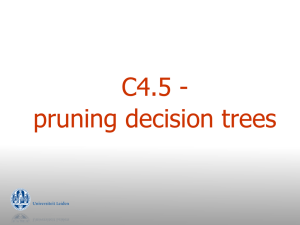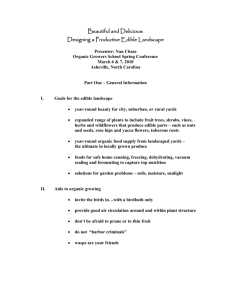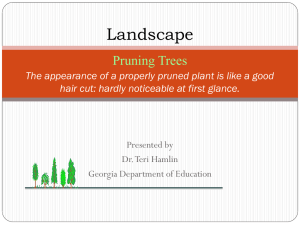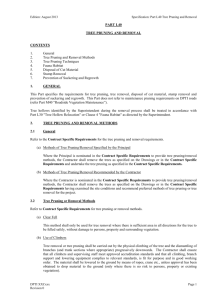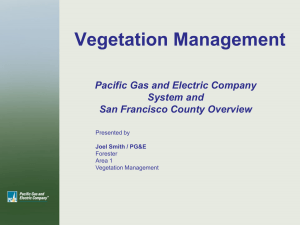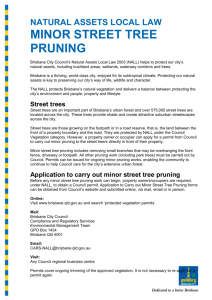Part M40 Maintenance Pruning
advertisement
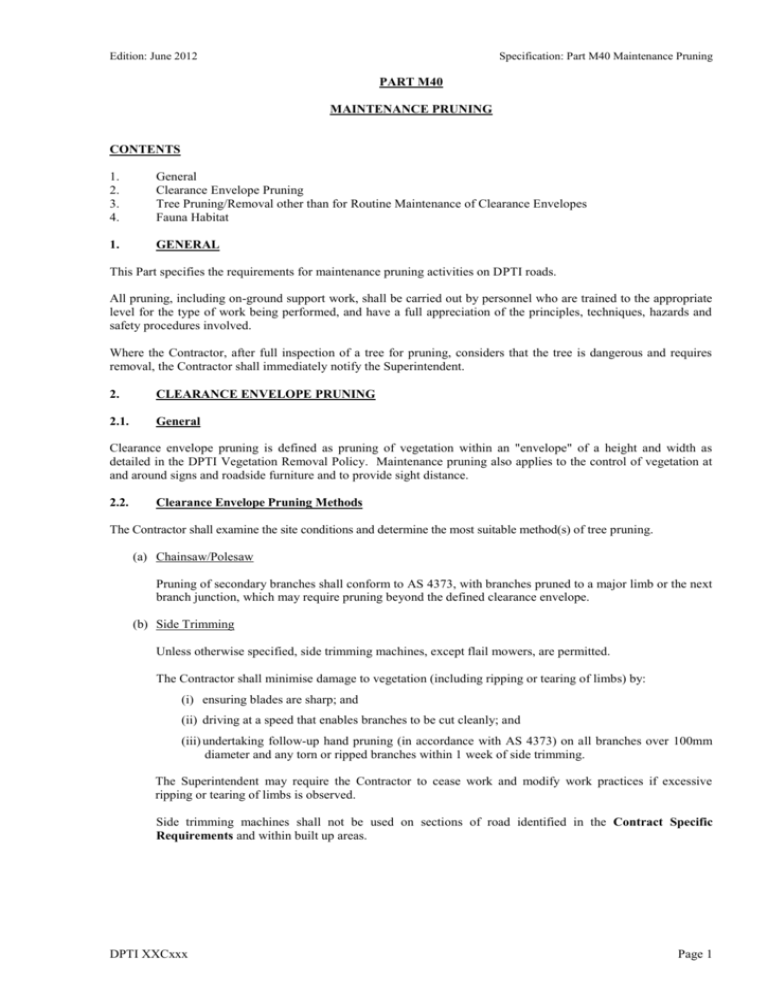
Edition: June 2012 Specification: Part M40 Maintenance Pruning PART M40 MAINTENANCE PRUNING CONTENTS 1. 2. 3. 4. General Clearance Envelope Pruning Tree Pruning/Removal other than for Routine Maintenance of Clearance Envelopes Fauna Habitat 1. GENERAL This Part specifies the requirements for maintenance pruning activities on DPTI roads. All pruning, including on-ground support work, shall be carried out by personnel who are trained to the appropriate level for the type of work being performed, and have a full appreciation of the principles, techniques, hazards and safety procedures involved. Where the Contractor, after full inspection of a tree for pruning, considers that the tree is dangerous and requires removal, the Contractor shall immediately notify the Superintendent. 2. CLEARANCE ENVELOPE PRUNING 2.1. General Clearance envelope pruning is defined as pruning of vegetation within an "envelope" of a height and width as detailed in the DPTI Vegetation Removal Policy. Maintenance pruning also applies to the control of vegetation at and around signs and roadside furniture and to provide sight distance. 2.2. Clearance Envelope Pruning Methods The Contractor shall examine the site conditions and determine the most suitable method(s) of tree pruning. (a) Chainsaw/Polesaw Pruning of secondary branches shall conform to AS 4373, with branches pruned to a major limb or the next branch junction, which may require pruning beyond the defined clearance envelope. (b) Side Trimming Unless otherwise specified, side trimming machines, except flail mowers, are permitted. The Contractor shall minimise damage to vegetation (including ripping or tearing of limbs) by: (i) ensuring blades are sharp; and (ii) driving at a speed that enables branches to be cut cleanly; and (iii) undertaking follow-up hand pruning (in accordance with AS 4373) on all branches over 100mm diameter and any torn or ripped branches within 1 week of side trimming. The Superintendent may require the Contractor to cease work and modify work practices if excessive ripping or tearing of limbs is observed. Side trimming machines shall not be used on sections of road identified in the Contract Specific Requirements and within built up areas. DPTI XXCxxx Page 1 Edition: June 2012 2.3. Specification: Part M40 Maintenance Pruning Disposal of Cut Material The Contractor may use an approved motorised chipping unit to process the cut material. The unit shall be in good working order, shall comply with all applicable OHS&W, noise and spark arrestor requirements, and shall be operated only by trained operators equipped with appropriate personal safety equipment. Unless otherwise specified, chipped prunings may be spread evenly over the ground taking care to avoid indigenous grasses and ground covers. The spread chippings are not to exceed 100 mm in depth across the site. Chipped prunings may not be spread in Roadside Significant Sites containing high value native vegetation or rare flora. Roadside Significant Sites relevant to this contract are identified in the Contract Specific Requirements. Cut vegetation containing seeds of environmental weed species shall not be spread within the road verge. Such material must be disposed of at a licensed waste facility or burnt. In High Risk Phytophthora (Dieback) areas, all cut material that has been in contact with soil shall be disposed of at a licensed waste depot or burnt. High Risk Phytophthora (Dieback) areas are listed in the Contract Specific Requirements. 3. TREE PRUNING/REMOVAL OTHER THAN FOR ROUTINE MAINTENANCE OF CLEARANCE ENVELOPES 3.1. General All pruning shall conform to AS 4373 "Pruning of Amenity Trees". Equipment that wounds the bark or conductive tissues (i.e. spurs, spikes, hooks) shall not be used on sections of the tree to be retained. All cutting tools shall be sharp and branches shall be undercut to prevent splitting or tearing of the branch collar or trunk. 3.2. Tree Pruning/Removal Methods Prior to tree pruning or removal, the Contractor shall assess the site conditions as well as the tree’s health, growth habit, structure, and stability and pruning requirements. Based on this assessment, the Contractor shall select the most suitable method of tree pruning/removal from the methods below. (a) Deadwooding Deadwood shall be removed from the tree. (b) Selective Pruning Branches identified by the Superintendent shall be removed. (c) Clear Fell This method shall only be used for tree removal where there is sufficient area in all directions for the tree to be felled safely, without damage to persons, property and surrounding vegetation. (d) Use of Climbers Tree removal or tree pruning shall be carried out by the physical climbing of the tree and the dismantling of branches (and trunk sections where appropriate) progressively downwards. The Contractor shall ensure that all climbers and supervising staff meet approved accreditation standards and that all climbing, branch support and lowering equipment complies to relevant standards, is fit for purpose and in good working order. The material shall be lowered to the ground by means of ropes, crane etc., unless approval has been obtained to drop material to the ground (only where there is no risk to persons, property or existing vegetation). (e) Elevated Platform This method shall be used where machinery access is available, with one or two operators in a basket traveling up in the crown to remove branches. The Contractor shall ensure operating staff have received approved training in use of this equipment. The material shall be lowered to the ground by means of ropes, DPTI XXCxxx Page 2 Edition: June 2012 Specification: Part M40 Maintenance Pruning crane etc., unless approval has been obtained to drop material to the ground (only where there is no risk to persons, property or existing vegetation). 3.3. Disposal of Cut Material The maintenance operation shall be carried out in a manner involving minimal movements across the site resulting in minimal disturbance to the vegetation, soil and watercourses. The Contractor may use an approved motorised chipping unit to process the cut material. The unit shall be in good working order, shall comply with all applicable OHS&W, noise and spark arrestor requirements, and shall be operated only by trained operators equipped with appropriate personal safety equipment. All material generated from pruning and removal activities must be removed from the site, unless prior written consent from the Superintendent is obtained. All non indigenous plant species shall be disposed of at licensed waste depot and the contractor shall be responsible for obtaining all necessary permits to undertake this activity. In High Risk Phytophthora (Dieback) areas, all cut material that has been in contact with soil shall be disposed of at a licensed waste depot or burnt. Where approval by the Superintendent is given in writing, the following disposal methods shall be permitted: (a) Native indigenous chipped prunings may be spread evenly over the ground taking care to avoid indigenous vegetation including but not limited to grasses and ground covers. The spread chippings are not to exceed 100 mm in depth across the site. (b) Non indigenous plant species may be left on site where they provide protection to exposed soil, will not inhibit regeneration of indigenous species, will not significantly increase the current fuel load at the site and do not contain seed. (c) Cut material may be burnt on site or at a suitable location proposed by the Contractor and approved by the Superintendent. The Contractor shall comply with all fire bans and restrictions, and shall obtain an appropriate permit to carry out burning. 4. FAUNA HABITAT The removal of trees, particularly in rural and remote areas, often results in the removal of hollows. These hollows have important habitat values for indigenous fauna species. Where hollows are encountered during the tree removal process, the Superintendent shall be contacted to arrange suitable relocation. Every effort shall be made to avoid the disturbance of native fauna occupying tree hollows. In the event of the discovery of occupied nests or hollows, or injured fauna, the Superintendent shall be immediately notified. ______________ DPTI XXCxxx Page 3
